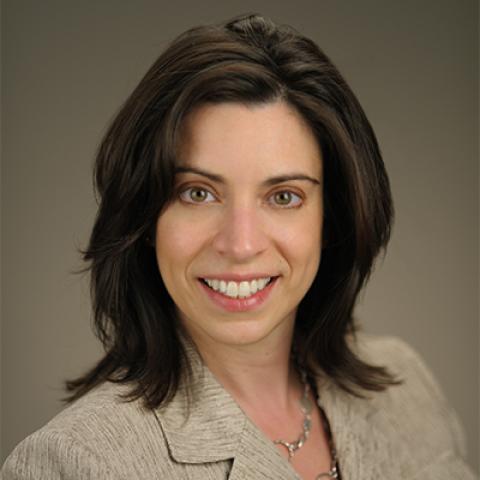
Christina Annunziata, M.D., Ph.D.
Christina Annunziata, M.D., Ph.D., is an Investigator in the Women’s Malignancies Branch at the Center for Cancer Research. She has spent most of her career studying the molecular underpinnings of ovarian cancer with the goal of discovering novel treatments. In our Q&A, Dr. Annunziata discusses her personal and professional milestones as well as new directions for her research.
What are your current research interests?
Our research is geared to finding different ways to treat ovarian cancer. Some of what we do focuses on how to attack tumor cells directly while other projects investigate how to interrupt pathways that promote tumor growth. In particular, we have homed in on one pathway, NF-kB, which plays a key role in immune response to infection. Earlier research showed that the more active NF-kB is, the more aggressive the ovarian tumor. This finding led us to a search for treatments that would block NF-kB signaling and promote tumor death. One small clinical trial with 11 women showed that Birinapant, a drug designed for this purpose, stabilized tumor growth in two patients, but it did not decrease the patients’ tumor burden. We are now developing a second protocol that will include other drugs, which we hope will boost the overall response.
Within those interests, what question or challenge are you currently pursuing?
We’re looking for novel approaches to add to the arsenal of treatments available for ovarian cancer patients. In a recent clinical trial, we enrolled 18 women with metastatic, chemotherapy-resistant ovarian cancer. We treated them with a combination of their own monocytes, or white blood cells, stimulated with interferon alpha and gamma cytokines, which we had shown in the lab was effective in killing ovarian cancer cells. This combination was injected directly into the peritoneal cavity.
Over the trial period, four patients’ disease did not progress for six to 11 months. We believe, however, that we could get a better response by adding chemotherapy and an immune checkpoint inhibitor to the mix. Before we begin such an effort, though, we amended the trial to collect additional tumor specimens to see what the therapy is actually doing to the tumor. This work has just begun, and we’ll be monitoring our patients closely to see how the body absorbs these drugs.
What sets your research apart from others in your field?
We have a unique niche in that we focus on translating therapies from the lab to first-in-human clinical trials, and then we collect detailed specimens in order to understand how they work and how they can be improved. The focus on NF-kB also puts us at the intersection of studying both the tumor and its unique microenvironment in the peritoneal cavity. From there, we can design novel approaches for treatment tailored to gynecologic cancers.
What sparked your interest in research?
When I was an undergraduate at Georgetown University, I worked in the lab of a woman who was studying malaria. She was looking at the immune response to malaria and what antibodies patients developed from exposure to the disease. There was a medical focus to her research that changed my thinking about what graduate degrees to pursue. Previously, I had thought I would go for a Ph.D., but this experience prompted me to enter the M.D./Ph.D. program at Georgetown instead. When I came to NCI as a postdoc, I was fortunate to work in the lab of Lou Staudt, M.D., Ph.D., Chief of the Lymphoid Malignancies Branch. In his lab, we were studying cancer of the immune cells. In the clinic, I worked with Elise C. Kohn, M.D., who encouraged me to apply this work to ovarian cancer. Although the type of cancer was different, both relied on the NF-kB pathway to promote tumor growth. Both of these mentors had a huge influence on my thinking about research.
How does the intramural environment of CCR help your research?
I love the back-and-forth of translational research where we learn something in the lab and then test it in the clinic. The bench-to-bedside approach is very collaborative with clinical researchers and those of us who are focused on research in the lab coming together to find answers to questions. In fact, I would say that what we learn in the clinic often becomes the driver for lab research.
What advice do you have for future generations of cancer researchers/physicians?
I always come back to something I learned in Lou’s lab—don’t shy away from the big problems. Plan your research with the goal of finding answers. By the same token, don’t overlook the smallest details either. Those may be the start of a new direction and a new discovery.